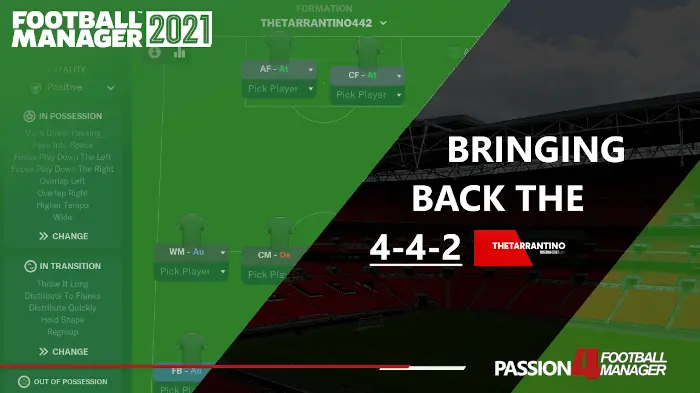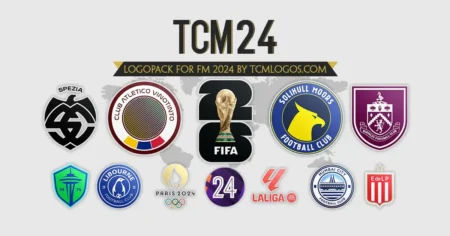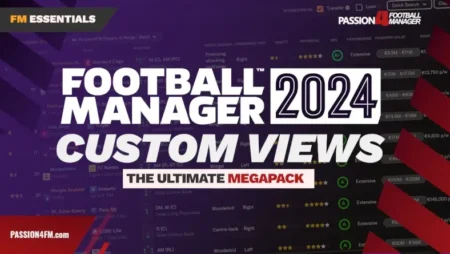Football Manager 2021 Tactics The Tarrantino’s 4-4-2
Welcome to TheTarrantino’s first tactics talk piece for Passion4FM. Today I want to look into how I’m approaching bringing back the 4-4-2 system in Football Manager 2021. 4-4-2 is one of the most traditional tactical systems and here I’ll examine the player roles and duties setup to make a 4-4-2 formation work in Football Manager.
I will be kicking off my first tactics piece with the formation I grew up watching: The 4-4-2. We will be looking at the specific roles for each position including what to look for in a player and how the team should be encouraged to play as a unit when on and off the ball in attacking and defensive situations.
The 4-4-2 is the more ‘basic’ of tactics and was the standard setup for most football clubs and national teams during the late 90’s and early 00’s before your Jose Mourinho’s and Pep Guardiola’s turned up and changed the game as a whole with unique tactical setups and foundations. An exciting time for football.
Why the 4-4-2?
As I said it can be viewed as ‘basic’ but it can also be a safe option at the beginning of a save. A flat back four and midfield with two strikers. It is not too heavy at either end of the pitch and provides the correct balance in numbers for both attacking and defensive phases of the game.
Your 4-4-2 may eventually evolve into a 4-5-1 or a 4-3-3 as you chop and change to make your ultimate tactic, rotate players and fit new signings in that require to be facilitated in positions that require a specified role such as a DM or CAM for instance.
The tactic can also easily be adapted depending on the situation you find yourself in during a match, but I’ll provide a short walkthrough on that later.
Who do you think of when you hear 4-4-2?
My mind wanders straight to the Manchester United team that won the treble in the 1998/99 season and the unforgettable Leicester City team that shocked the world by winning the Premier League in 2016.
Diego Simeone’s Atletico Madrid stunned Spain in 2014 using the 4-4-2 and winning La Liga, leaving perennial runaway winners Barcelona and Real Madrid baffled.
But before we get into the tactical side of things, I think we should look back on the origins of the formation and understand the root cause of its creation.
You must go all the way back to 1966 to find the first use of the 4-4-2. England manager Alf Ramsey was the first to employ the formation although the midfield four were narrower at the time compared to that of the 90’s and 00’s.
The reasoning was that a narrow four up against the oppositions two in the centre of midfield would make it easier to stay in possession and offer more passing options from the back to the front. A technique that Guardiola used and adapted to new levels whilst managing Barcelona.
It worked well for Alf Ramsey as England won the World Cup. The success of the 4-4-2 skyrocketed from there as many English clubs adopted this style. Liverpool won numerous European Cups using the tried and tested strategy.
As is the norm in football a tactic can be copied but a spin added to it. That is exactly what happened when teams in Italy began to roll out the 4-4-2 but instead of the traditional flat four across midfield they tended to go with a diamond.
A central holding midfielder sitting behind two central midfielders and another one further forward just in front of what you would call the traditional ‘CAM’ position. AC Milan obtained a lot of success with the diamond addition under Arrigo Sacchi as the 1990’s approached.
That is the history lesson over so now let us create a 4-4-2 system of our own. I have created a 4-4-2 myself and I will break the positions down with a short description of what you will be wanting from them during a match.
TheTarrantino’s Standard 4-4-2
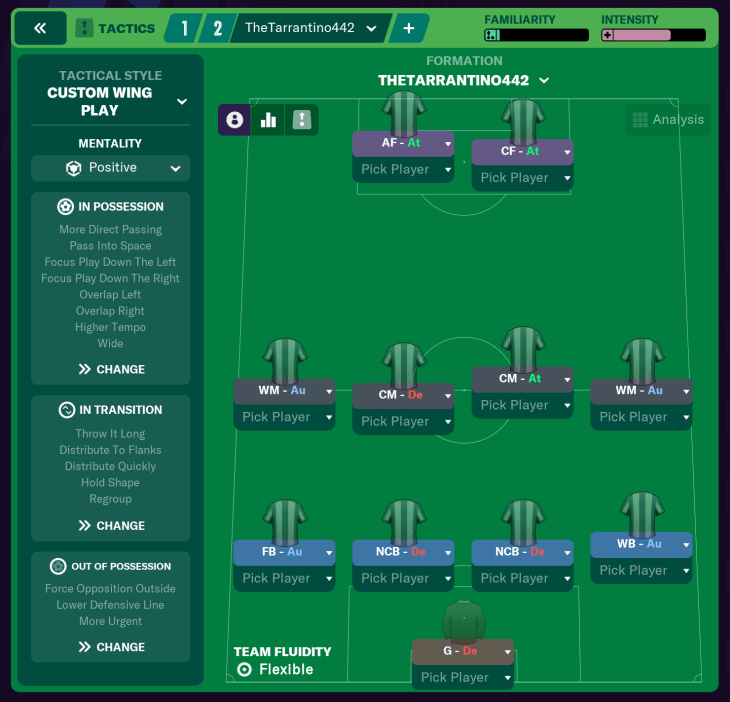
This is my standard 4-4-2 formation.
Goalkeeper
You will want your man in between the sticks to distribute quickly. Normally when your goalkeeper picks up on the ball that means that an opposition attack has ended and are out of position. Therefore, you want the ball back in play quickly to take advantage of that.
Distribution to the flanks will see your wide midfielders (who should be your most creative players) pick up the ball and start on the attack.
Right & Left Full Backs
Like the wide midfielders that we will talk about shortly, your full-backs are going to have to be tiresome. You want your wide players to parade up and down the pitch as much as possible. When on the ball they push forward and overlap whilst off the ball they are back to defend.
You will want your full-backs to have high stamina as well as technical attributes such as crossing as they will be expected to play a big part in the attacking phase of play.
Centre Backs:
Relatively simple this one but there are personal tastes to how you might want your centre half duo to play. I want them as no-nonsense CB’s. Their primary job (and only mission as far as I am concerned) is to head and kick the ball away as far as possible.
That is all I would ever want from them as a minimum requirement. However, if you want you can have them set to play a short passing game when winning possession. But as I said, it is down to personal taste here. Strength and aerial attributes are vital here as a minimum.
Wide Midfielders:
Your wide midfielders have two things they need to do: play wide and stay wide. They open the game for you these two. When on the ball they need to move directly towards goal to provide the balls into your front men and the central midfielder running in to support them.
They will also be expected to track back when your side is not possession so once again as I said with the full-backs; stamina is important. Technical attributes such as pace & acceleration are something to look for here too.
Central Midfielder (Defend):
Your two central midfielders will basically be opposites of each other when on the ball but off the ball, they will play the same role. On the ball, this midfielder will stay back and guard the centre backs as your full-backs join the attack.
Off the ball it is relatively the same job for this player, you never really want them to leave their station as the holding midfielder. Have them set to avoid venturing forward at all times unless perhaps trailing in the game.
Central Midfielder (Attack):
Your second central midfielder will help out with defending and make up the numbers when off the ball but when on the ball he needs to be helping move attacks forward and be busting a gut to get into the box to score goals when the wide midfielders are running up the wings.
Strikers:
Both of your strikers will remain up top. There’s no need for them to defend, they can do that from the front if you want but in reality, you just want them to score the goals. I have mine set as advanced and complete forwards but feel free to tailor the role to that of what suits your strikers.
There are various choices for the front men you can try.
For me personally, it would be a creative striker alongside a poacher; a Wayne Rooney/Ruud Van Nistelrooy kind of partnership. For you or others it could be a Michael Owen/Emile Heskey or a Jermain Defoe/Peter Crouch type of combination.
Tactical Variants of the 4-4-2
Now, as stated before that is the standard 4-4-2 setup. During a 90-minute match you are going to be making many changes to combat what is happening on the pitch and I have two deviations of from the two banks of four.
One to be used to attack the game (possibly when trailing) and the other to be used to defend in numbers but still be able to counter (when leading 1-0 late on for example).
Variant 1 – Attacking
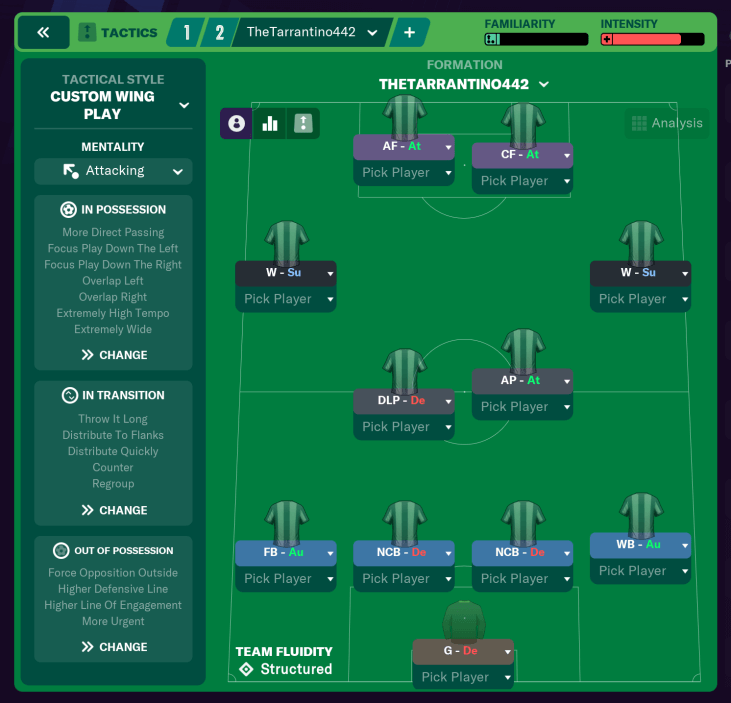
Above is the attacking version of my 4-4-2. The only difference you will see visually on the tactics screen is that both wide midfielders have been pushed forward as wingers. They remain in the support role as their job is still to provide support up and down the field at all times. When possession is gained, they will push up further on the other side of the opposition’s wide men to find themselves in more space.
You will also notice the tactical instructions are different. No more passing into space here as you want to be more direct. You will also be using an ‘extremely high tempo’ to get back into the match. You need that ball back quickly and when you get it you need to exploit your opponent’s being out of position by getting the ball forward quickly.
In transition, you will now counter rather than regroup as well as having a higher line of engagement and defensive line to keep the game further up the pitch from your goal as possible with the aim to pick up the long balls and once again begin attacks. Forcing the opposition out wide is also handy here.
Variant 2 – Defending

When protecting the lead, I choose to drop my two central midfielders back in front of the defence to provide an extra barrier. I’ve set them as defensive midfielders here but if you have any players who can perform the anchorman role then I’d suggest going with that instead as they tend to stay in position rather than wandering up the pitch.
When out of the possession you want your players to stay back and hold position so go for a lower line of engagement and a lower defensive line. It will create a ‘low block’ as it is more commonly known these days where the opposition can only find a way through by being creative and passing their way through which is difficult when there are more numbers in front of them.
Tighter marking is selected here too. Going man for man in this instance means every player should be tracked and find space hard to come by. You also want a shorting passing game. You want to be keeping the ball. If you have the ball your opponents can’t score, it really is as simple as that.
That said, your team will still attack but without taking unnecessary risks. If the ball is lost your team should be set to regroup and hold position. The more organised your team are the less likely it is for your lead to evaporate.
You still may be able to nick a goal on the counter-attack as when moving the ball forward you will still have your two wide midfielders and two front men up the pitch which could leave you with a 4 vs 4 scenarios or better if your opposition is throwing the kitchen sink trying to get back into the game.
Conclusion
I think you will all agree when I stated that the 4-4-2 is a basic, safe and wonderful formation to start with as it provides you with everything you need; correct numbers in areas of the field and a gentle balance between attacking & defending.
The formation also offers up the opportunity to shift players between the lines to create an attacking 4-2-4 and a defensive 4-2-2-2, both of which can be done in seconds depending on how the game is unfolding in front of you.
I hope this has been of use to you in your pursuit of bringing back the trusted 4-4-2.
Not that it ever really went away…
Download TheTarrantinos Football Manager 2021 4-4-2 Tactics
Try out one of the most traditional football tactics by bringing back 4-4-2 to your tactical repertoire. Download TheTarrantinos 4-4-2 systems and turn back time.


